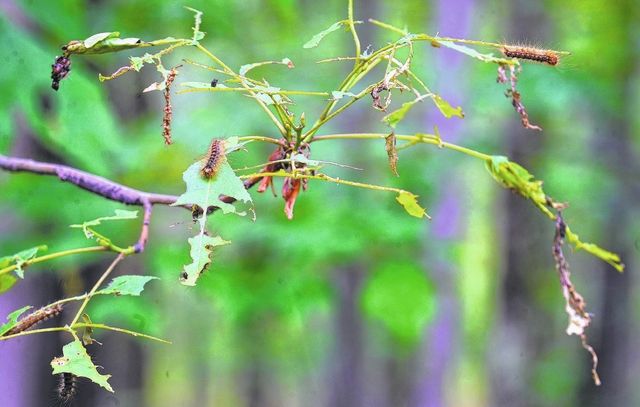Click here to subscribe today or Login.
More than 3,000 acres of private property in Luzerne County soon will be sprayed to ward off gypsy moth caterpillars that caused widespread defoliation last year.
The property owners signed up for the state spraying program, which was coordinated by the county, by last summer’s deadline.
Some property owners were interested but withdrew due to the cost.
The state Department of Conservation and Natural Resources, which oversees the spraying, charged $55 per acre and required the spraying of a 500-foot buffer around each residence. Those with small lots paid for up to 23 acres — $1,265 — if adjacent property owners within that buffer wouldn’t share in the cost.
A few requests also were canceled because all property owners within a shared buffer zone would not consent to the spraying as required, officials said.
The private properties to be sprayed are in 28 municipalities, said county staff engineer Keri Skvarla, who also serves as the county gypsy moth coordinator.
The greatest participation is in the Mountain Top area, including about 900 acres in Rice Township and 500 acres in Wright Township, Skvarla said.
The other townships scheduled for treatment include Bear Creek, Black Creek, Butler, Conyngham, Dallas, Dennison, Dorrance, Fairmount, Fairview, Foster, Hanover, Hollenback, Hunlock, Jackson, Kingston, Lehman, Pittston, Plains, Plymouth, Ross, Slocum and Union.
Private properties in four boroughs also will be sprayed: Dallas, Harveys Lake, Laurel Run and Luzerne.
Spraying planes are expected to start sweeping through Luzerne County around mid-May, but the schedule will depend on caterpillar and leaf development, Skvarla said.
Detailed maps of the treatment areas, which will be updated daily, are available at http://www.gis.dcnr.state.pa.us/maps/index.html?gypsymoth=true.
A biological insecticide, Bacillus thuringiensis var. kurstaki, will be used, but there are no guarantees, Skvarla warned.
In severe infestations, the percentage of caterpillars surviving the spraying may be high enough to cause some defoliation and be a nuisance to property owners, she said.
The spraying will start at daybreak and continue if wind and other weather conditions are suitable, possibly in the evenings and on weekends. Only one treatment typically is applied at each property.
Pilots will target forested areas but not open fields with only a few trees, she said.
This type of insecticide has not been deemed harmful to humans, pets, livestock, or gardens, but the state recommends residents remain under cover during spraying, she said.
Those exposed to spraying should wash with soap and water, she said.
State and county officials advised property owners to consider hiring private contractors if they can’t afford the state spraying.
County officials did not embrace a proposal to fund the spraying because the county would have had to come up with more than $1 million to cover the 21,272 acres requested by private property owners.
A gypsy moth outbreak last spring prompted a public outcry for the county’s participation in the state spraying program.
State officials had said egg masses indicated there would be a “severe” gypsy moth problem in the county this year if the spring is dry and warm. Healthy trees can usually survive one year of defoliation, but a second year in a row can be deadly, state officials say.
Skvarla said the recent rain and cold should help reduce the pest population.
Questions regarding gypsy moths, the insecticide or the state spraying program should be directed to Skvarla at 570-820-6347 or [email protected].





